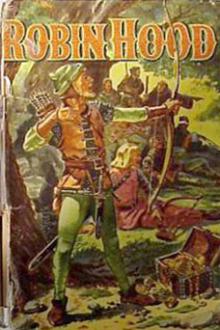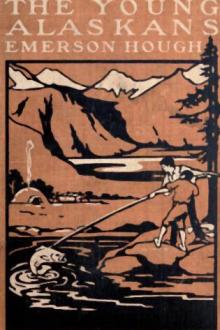Moby-Dick; or, The Whale by Herman Melville (uplifting books for women TXT) 📕

Read free book «Moby-Dick; or, The Whale by Herman Melville (uplifting books for women TXT) 📕» - read online or download for free at americanlibrarybooks.com
- Author: Herman Melville
Read book online «Moby-Dick; or, The Whale by Herman Melville (uplifting books for women TXT) 📕». Author - Herman Melville
There are only two books in being which at all pretend to put the living sperm whale before you, and at the same time, in the remotest degree succeed in the attempt. Those books are Beale’s and Bennett’s; both in their time surgeons to English South-Sea whale-ships, and both exact and reliable men. The original matter touching the sperm whale to be found in their volumes is necessarily small; but so far as it goes, it is of excellent quality, though mostly confined to scientific description. As yet, however, the sperm whale, scientific or poetic, lives not complete in any literature. Far above all other hunted whales, his is an unwritten life.
Now the various species of whales need some sort of popular comprehensive classification, if only an easy outline one for the present, hereafter to be filled in all its departments by subsequent laborers. As no better man advances to take this matter in hand, I hereupon offer my own poor endeavors. I promise nothing complete; because any human thing supposed to be complete, must for that very reason infallibly be faulty. I shall not pretend to a minute anatomical description of the various species, or—in this place at least—to much of any description. My object here is simply to project the draught of a systematization of cetology. I am the architect, not the builder.
But it is a ponderous task; no ordinary letter-sorter in the Post-office is equal to it. To grope down into the bottom of the sea after them; to have one’s hands among the unspeakable foundations, ribs, and very pelvis of the world; this is a fearful thing. What am I that I should essay to hook the nose of this leviathan! The awful tauntings in Job might well appal me. “Will he (the leviathan) make a covenant with thee? Behold the hope of him is vain!” But I have swam through libraries and sailed through oceans; I have had to do with whales with these visible hands; I am in earnest; and I will try. There are some preliminaries to settle.
First: the uncertain, unsettled condition of this science of Cetology is in the very vestibule attested by the fact, that in some quarters it still remains a moot point whether a whale be a fish. In his System of Nature, A.D. 1776, Linnæus declares, “I hereby separate the whales from the fish.” But of my own knowledge, I know that down to the year 1850, sharks and shad, alewives and herring, against Linnæus’s express edict, were still found dividing the possession of the same seas with the Leviathan.
The grounds upon which Linnæus would fain have banished the whales from the waters, he states as follows: “On account of their warm bilocular heart, their lungs, their movable eyelids, their hollow ears, penem intrantem feminam mammis lactantem,” and finally, “ex lege naturæ jure meritoque.” I submitted all this to my friends Simeon Macey and Charley Coffin, of Nantucket, both messmates of mine in a certain voyage, and they united in the opinion that the reasons set forth were altogether insufficient. Charley profanely hinted they were humbug.
Be it known that, waiving all argument, I take the good old fashioned ground that the whale is a fish, and call upon holy Jonah to back me. This fundamental thing settled, the next point is, in what internal respect does the whale differ from other fish. Above, Linnæus has given you those items. But in brief, they are these: lungs and warm blood; whereas, all other fish are lungless and cold blooded.
Next: how shall we define the whale, by his obvious externals, so as conspicuously to label him for all time to come? To be short, then, a whale is a spouting fish with a horizontal tail. There you have him. However contracted, that definition is the result of expanded meditation. A walrus spouts much like a whale, but the walrus is not a fish, because he is amphibious. But the last term of the definition is still more cogent, as coupled with the first. Almost any one must have noticed that all the fish familiar to landsmen have not a flat, but a vertical, or up-and-down tail. Whereas, among spouting fish the tail, though it may be similarly shaped, invariably assumes a horizontal position.
By the above definition of what a whale is, I do by no means exclude from the leviathanic brotherhood any sea creature hitherto identified with the whale by the best informed Nantucketers; nor, on the other hand, link with it any fish hitherto authoritatively regarded as alien[3]. Hence, all the smaller, spouting, and horizontal tailed fish must be included in this ground-plan of Cetology. Now, then, come the grand divisions of the entire whale host.
[3] I am aware that down to the present time, the fish styled Lamatins and Dugongs (Pig-fish and Sow-fish of the Coffins of Nantucket) are included by many naturalists among the whales. But as these pig-fish are a nosy, contemptible set, mostly lurking in the mouths of rivers, and feeding on wet hay, and especially as they do not spout, I deny their credentials as whales; and have presented them with their passports to quit the Kingdom of Cetology.
First: According to magnitude I divide the whales into three primary BOOKS (subdivisible into CHAPTERS), and these shall comprehend them all, both small and large.
I. The FOLIO WHALE; II. the OCTAVO WHALE; III. the DUODECIMO WHALE.
As the type of the FOLIO I present the Sperm Whale; of the OCTAVO, the Grampus; of the DUODECIMO, the Porpoise.
FOLIOS. Among these I here include the following chapters:—I. The Sperm Whale; II. the Right Whale; III. the Fin Back Whale; IV. the Hump-backed Whale; V. the Razor Back Whale; VI. the Sulphur Bottom Whale.
BOOK I. (Folio), CHAPTER I. (Sperm Whale).—This whale, among the English of old vaguely known as the Trumpa whale, and the Physeter whale, and the Anvil Headed whale, is the present Cachalot of the French, and the Pottfisch of the Germans, and the Macrocephalus of the Long Words. He is, without doubt, the largest inhabitant of the globe; the most formidable of all whales to encounter; the most majestic in aspect; and lastly, by far the most valuable in commerce; he being the only creature from which that valuable substance, spermaceti, is obtained. All his peculiarities will, in many other places, be enlarged upon. It is chiefly with his name that I now have to do. Philologically considered, it is absurd. Some centuries ago, when the Sperm whale was almost wholly unknown in his own proper individuality, and when his oil was only accidentally obtained from the stranded fish; in those days spermaceti, it would seem, was popularly supposed to be derived from a creature identical with the one then known in England as the Greenland or Right Whale. It was the idea also, that this same spermaceti was that quickening humor of the Greenland Whale which the first syllable of the word literally expresses. In those times, also, spermaceti was exceedingly scarce, not being used for light, but only as an ointment and medicament. It was only to be had from the druggists as you nowadays buy an ounce of rhubarb. When, as I opine, in the course of time, the true nature of spermaceti became known, its original name was still retained by the dealers; no doubt to enhance its value by a notion so strangely significant of its scarcity. And so the appellation must at last have come to be bestowed upon the whale from which this spermaceti was really derived.
BOOK I. (Folio), CHAPTER II. (Right Whale).—In one respect this is the most venerable of the leviathans, being the one first regularly hunted by man. It yields the article commonly known as whalebone or baleen; and the oil specially known as “whale oil,” an inferior article in commerce. Among the fishermen, he is indiscriminately designated by all the following titles: The Whale; the Greenland Whale; the Black Whale; the Great Whale; the True Whale; the Right Whale. There is a deal of obscurity concerning the identity of the species thus multitudinously baptized. What then is the whale, which I include in the second species of my Folios? It is the Great Mysticetus of the English naturalists; the Greenland Whale of the English Whalemen; the Baliene Ordinaire of the French whalemen; the Growlands Walfish of the Swedes. It is the whale which for more than two centuries past has been hunted by the Dutch and English in the Arctic seas; it is the whale which the American fishermen have long pursued in the Indian ocean, on the Brazil Banks, on the Nor’ West Coast, and various other parts of the world, designated by them Right Whale Cruising Grounds.
Some pretend to see a difference between the Greenland whale of the English and the right whale of the Americans. But they precisely agree in all their grand features; nor has there yet been presented a single determinate fact upon which to ground a radical distinction. It is by endless subdivisions based upon the most inconclusive differences, that some departments of natural history become so repellingly intricate. The right whale will be elsewhere treated of at some length, with reference to elucidating the sperm whale.
BOOK I. (Folio), CHAPTER III. (Fin-Back).—Under this head I reckon a monster which, by the various names of Fin-Back, Tall-Spout, and Long-John, has been seen almost in every sea and is commonly the whale whose distant jet is so often descried by passengers crossing the Atlantic, in the New York packet-tracks. In the length he attains, and in his baleen, the Fin-back resembles the right whale, but is of a less portly girth, and a lighter color, approaching to olive. His great lips present a cable-like aspect, formed by the intertwisting, slanting folds of large wrinkles. His grand distinguishing feature, the fin, from which he derives his name, is often a conspicuous object. This fin is some three or four feet long, growing vertically from the hinder part of the back, of an angular shape, and with a very sharp pointed end. Even if not the slightest other part of the creature be visible, this isolated fin will, at times, be seen plainly projecting from the surface. When the sea is moderately calm, and slightly marked with spherical ripples, and this gnomon-like fin stands up and casts shadows upon the wrinkled surface, it may well be supposed that the watery circle surrounding it somewhat resembles a dial, with its style and wavy hour-lines graved on it. On that Ahaz-dial the shadow often goes back. The Fin-Back is not gregarious. He seems a whale-hater, as some men are man-haters. Very shy; always going solitary; unexpectedly rising to the surface in the remotest and most sullen waters; his straight and single lofty jet rising like a tall misanthropic spear upon a barren plain; gifted with such wondrous power and velocity in swimming, as to defy all present pursuit from man; this leviathan seems the banished and unconquerable Cain of his race, bearing for his mark that style upon his back. From having the baleen in his mouth, the Fin-Back is sometimes included with the right whale, among a theoretic species denominated Whalebone whales, that is, whales with baleen. Of these so called Whalebone whales, there would seem to be several varieties, most of which, however, are little known. Broad-nosed whales and beaked whales; pike-headed whales; bunched whales; under-jawed whales and rostrated whales, are the fishermen’s names for a few sorts.
In connexion with this appellative of “Whalebone whales,” it is of great importance to mention, that however such a nomenclature may be convenient in facilitating allusions to some kind of whales, yet it is in vain to attempt a clear classification of the Leviathan, founded upon either his baleen, or hump, or fin, or teeth; notwithstanding that those





Comments (0)